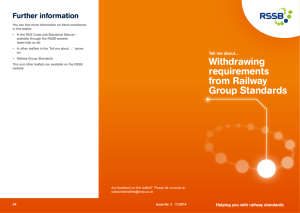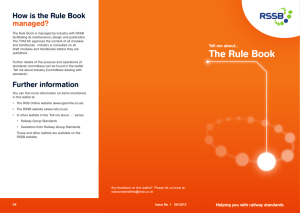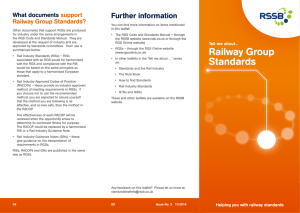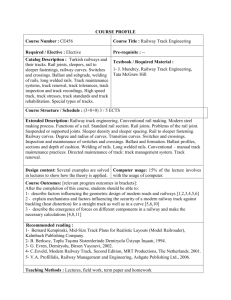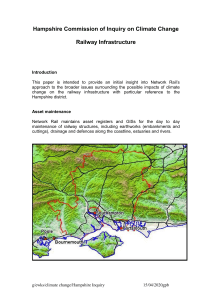Document 11416090
advertisement
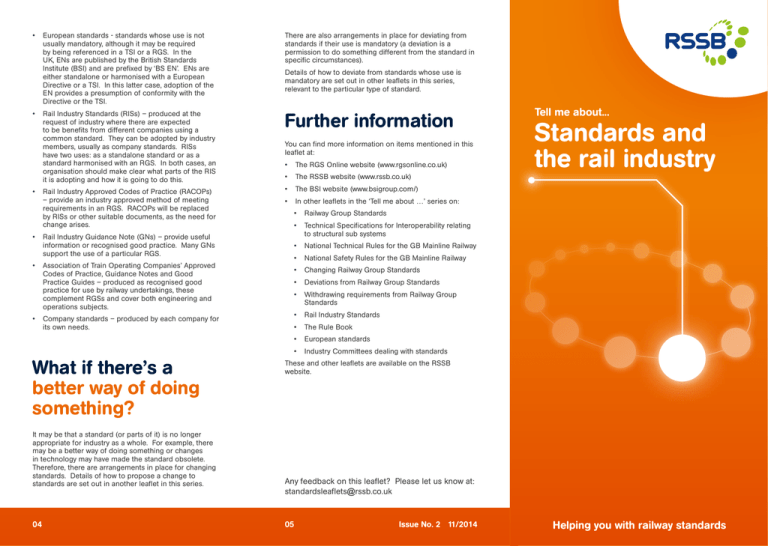
• European standards - standards whose use is not usually mandatory, although it may be required by being referenced in a TSI or a RGS. In the UK, ENs are published by the British Standards Institute (BSI) and are prefixed by ‘BS EN’. ENs are either standalone or harmonised with a European Directive or a TSI. In this latter case, adoption of the EN provides a presumption of conformity with the Directive or the TSI. There are also arrangements in place for deviating from standards if their use is mandatory (a deviation is a permission to do something different from the standard in specific circumstances). • Rail Industry Standards (RISs) – produced at the request of industry where there are expected to be benefits from different companies using a common standard. They can be adopted by industry members, usually as company standards. RISs have two uses: as a standalone standard or as a standard harmonised with an RGS. In both cases, an organisation should make clear what parts of the RIS it is adopting and how it is going to do this. Further information • Rail Industry Approved Codes of Practice (RACOPs) – provide an industry approved method of meeting requirements in an RGS. RACOPs will be replaced by RISs or other suitable documents, as the need for change arises. • The BSI website (www.bsigroup.com/) • Rail Industry Guidance Note (GNs) – provide useful information or recognised good practice. Many GNs support the use of a particular RGS. • Association of Train Operating Companies’ Approved Codes of Practice, Guidance Notes and Good Practice Guides – produced as recognised good practice for use by railway undertakings, these complement RGSs and cover both engineering and operations subjects. • Company standards – produced by each company for its own needs. Details of how to deviate from standards whose use is mandatory are set out in other leaflets in this series, relevant to the particular type of standard. You can find more information on items mentioned in this leaflet at: • The RGS Online website (www.rgsonline.co.uk) • The RSSB website (www.rssb.co.uk) Tell me about... Standards and the rail industry • In other leaflets in the ‘Tell me about …’ series on: • Railway Group Standards • Technical Specifications for Interoperability relating to structural sub systems • National Technical Rules for the GB Mainline Railway • National Safety Rules for the GB Mainline Railway • Changing Railway Group Standards • Deviations from Railway Group Standards • Withdrawing requirements from Railway Group Standards • Rail Industry Standards • The Rule Book • European standards • Industry Committees dealing with standards What if there’s a better way of doing something? It may be that a standard (or parts of it) is no longer appropriate for industry as a whole. For example, there may be a better way of doing something or changes in technology may have made the standard obsolete. Therefore, there are arrangements in place for changing standards. Details of how to propose a change to standards are set out in another leaflet in this series. 04 These and other leaflets are available on the RSSB website. Any feedback on this leaflet? Please let us know at: standardsleaflets@rssb.co.uk 05 Issue No. 2 11/2014 Helping you with railway standards • People in the rail industry who need to have a general understanding about the purpose and types of standards. The leaflet may be helpful to: • Organisations who are involved in providing support (such as training) to the rail industry or who do business with the rail industry (such as local authorities or suppliers). The GB mainline railway is the GB railway system excluding trams, metros, and infrastructure and vehicles reserved for local use, for tourism or to run a heritage railway. It also excludes some specified networks such as High Speed 1. Why does industry need standards? The aim of standards is to provide for the most costeffective, efficient and compatible means of rail system delivery, whilst providing for a safe railway. To meet this aim, standards define and record what has to be done or how something needs to be done. This avoids having to ‘re-invent the wheel’ each time the same situation occurs. There are three basic situations in which the industry uses standards: • When an appropriate authority has determined that a standard must be complied with under specified circumstances. • When the industry needs a recognised method of meeting a requirement that must be complied with – that is, something whose use gives a ‘presumption of conformity’ with that requirement. • When the industry needs access to useful information or recognised good practice. 01 A schematic showing the relationship between the scope and force of standards is provided at the end of this leaflet (Figure 1). FIGURE 1: THE SCOPE AND FORCE OF ST ANDARDS • The law – European (such as Commission decisions and Commission regulations) and domestic (such as regulations – a type of Statutory Instrument). • Licence conditions – imposed through the licence granted by the Office of Rail Regulation. • Safety Management Systems and contracts – imposed at company level. What scope do standards have? The scope of application of a standard will be at one of four levels: • European level, such as Technical Specifications for Interoperability (TSIs). Imposed by law Statutory Instruments Imposed by licence Railway Group Standards (RGS) Grant presumption of conformity Voluntary observation Rail Industry Approved Codes of Practice (RACOP) British Standards (BS) • National (or Network) level, such as Railway Group Standards (RGSs). • Company level. Commission Decisions and Regulations including TSIs Rail Industry Standards (RIS) SMS or contract COMPANY STANDARDS The leaflet may therefore be of interest to: The requirement to comply with standards under specified circumstances is given force by different means, depending on the ‘appropriate authority’ that requires compliance. These means are: Drawing this together PROJECT STANDARDS This is an introductory leaflet about standards applicable to the mainline railway in Great Britain (GB). Further leaflets describe in greater detail many of the subjects outlined in this leaflet. How are standards given force? Legal Force Introduction European Standards (EN) (harmonised) European Standards (EN) (not harmonised) Guidance Notes (GN) Guidance • Project level. Producing standards at different levels means that detailed requirements do not need to be imposed at high levels. This gives the industry the ability to make decisions at the right level. Generally speaking, requirements become more specific the lower the level of standard. For example, at national level, the standard will state what needs to be achieved to deliver compatibility between rail vehicles, the infrastructure and operating procedures. A company will create its own standards that are compatible with the national standards to define any further rules that it wishes to apply to its activities. RSSB has implemented a programme of work to consolidate the content of company standards of infrastructure managers (IMs), railway undertakings (RUs) and entities in charge of maintenance (ECMs) into requirements in Rail Industry Standards (RISs), where this will support improvements in the cost-effectiveness and efficiency of the industry. 02 Project Company Network European Scope Of Standards What kinds of standard are there? The principal types of standard used by the industry include the following, but note that other types of standards are also used: • TSIs – European standards, whose use under specified circumstances is required by law. • RGSs – standards for the GB mainline railway, whose use under specified circumstances is required by licence conditions. 03

